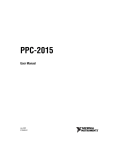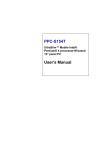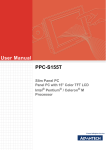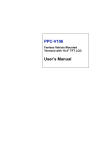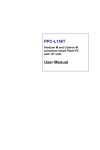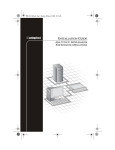Download Advantech PPC-S154T User`s manual
Transcript
PPC-154 Pentium® 4 Processor-Based Panel PC with 15" Color TFT LCD Display Users Manual Copyright This document is copyrighted, © 2004. All rights are reserved. The original manufacturer reserves the right to make improvements to the products described in this manual at any time without notice. No part of this manual may be reproduced, copied, translated or transmitted in any form or by any means without the prior written permission of the original manufacturer. Information provided in this manual is intended to be accurate and reliable. However, the original manufacturer assumes no responsibility for its use, nor for any infringements upon the rights of third parties that may result from such use. Acknowledgements Award is a trademark of Award Software International, Inc. VIA is a trademark of VIA Technologies, Inc. IBM, PC/AT, PS/2 and VGA are trademarks of International Business Machines Corporation. Intel and Pentium are trademarks of Intel Corporation. Microsoft Windows® is a registered trademark of Microsoft Corp. RTL is a trademark of Realtek Semi-Conductor Co., Ltd. Winbond is a trademark of Winbond electronics corporation. Ricoh is a trademark of Ricoh Company LTD. All other product names or trademarks are properties of their respective owners. For more information on this and other Advantech products, please visit our websites at: http://www.advantech.com http://www.advantech.com/ppc For technical support and service, please visit our support website at: http://support.advantech.com This manual is for the PPC-154. Part No. 2008015312 1st Edition Printed in Taiwan April. 2004 PPC-154 User’s Manual ii FCC Class B This equipment has been tested and found to comply with the limits for a Class B digital device, pursuant to Part 15 of the FCC Rules. These limits are designed to provide reasonable protection against harmful interference when the equipment is operated in a residential environment. This equipment generates, uses and can radiate radio frequency energy. If not installed and used in accordance with this user's manual, it may cause harmful interference to radio communications. Note that even when this equipment is installed and used in accordance with this user's manual, there is still no guarantee that interference will not occur. If this equipment is believed to be causing harmful interference to radio or television reception, this can be determined by turning the equipment on and off. If interference is occurring, the user is encouraged to try to correct the interference by one or more of the following measures: • Reorient or relocate the receiving antenna • Increase the separation between the equipment and the receiver • Connect the equipment to a power outlet on a circuit different from that to which the receiver is connected • Consult the dealer or an experienced radio/TV technician for help Warning! Any changes or modifications made to the equipment which are not expressly approved by the relevant standards authority could void your authority to operate the equipment. iii Packing List Before you begin installing your card, please make sure that the following materials have been shipped: • PPC-154 series panel PC • User's manual • Accessories for PPC-154 - Power cord (1.8 m) - USA type (other types are available on request) - Floppy disk with CD-ROM drive driver - "Drivers and Utilities" CD-ROM disc - Heat sink (optional) (refer to Notes 1 and 2 below) If any of these items are missing or damaged, contact your distributor or sales representative immediately. Note1: If the unit you have bought is basic (i.e. without a CPU, HDD, or SDRAM), you will find this optional item in the accessory box. Note2: If you install an Intel®processor yourself, you must install a heat sink above the CPU. This will avoid heat damage to the CPU. PPC-154 User’s Manual iv Additional Information and Assistance Step 1. Visit the Advantech web site at www.advantech.com where you can find the latest information about the product. Step 2. Contact your distributor, sales representative, or Advantech's customer service center for technical support if you need additional assistance. Please have the following information ready before you call: • Product name and serial number • Description of your peripheral attachments • Description of your software (operating system, version, application software, etc.) • A complete description of the problem • The exact wording of any error messages Warning! 1. Input voltage rated 100-240 VAC, 50/60 Hz, 4A 2. Use a 3 V @ 195 mA lithium battery 3. Packing: please carry the unit with both hands, handle with care 4. Maintenance: to properly maintain and clean the surfaces, use only approved products or clean with a dry applicator 5. CompactFlash: Turn off power before inserting or removing CompactFlash storage card. Contact information: Our European representative: Advantech Europe GmbH Kolberger Straße 7 D-40599 Düsseldorf, Germany Tel: 49-211-97477350 Fax: 49-211-97477300 v Safety Instructions 1. Read these safety instructions carefully. 2. Keep this User's Manual for later reference. 3. Disconnect this equipment from any AC outlet before cleaning. Use a damp cloth. Do not use liquid or spray detergents for cleaning. 4. For plug-in equipment, the power outlet socket must be located near the equipment and must be easily accessible. 5. Keep this equipment away from humidity. 6. Put this equipment on a reliable surface during installation. Dropping it or letting it fall may cause damage. 7. The openings on the enclosure are for air convection. Protect the equipment from overheating. DO NOT COVER THE OPENINGS. 8. Make sure the voltage of the power source is correct before connecting the equipment to the power outlet. 9. Position the power cord so that people cannot step on it. Do not place anything over the power cord. 10. All cautions and warnings on the equipment should be noted. 11. If the equipment is not used for a long time, disconnect it from the power source to avoid damage by transient overvoltage. 12. Never pour any liquid into an opening. This may cause fire or electrical shock. 13. Never open the equipment. For safety reasons, the equipment should be opened only by qualified service personnel. 14. If one of the following situations arises, get the equipment checked by service personnel: a. The power cord or plug is damaged. b. Liquid has penetrated into the equipment. c. The equipment has been exposed to moisture. d. The equipment does not work well, or you cannot get it to work according to the user's manual. e. The equipment has been dropped and damaged. f. The equipment has obvious signs of breakage. 15. DO NOT LEAVE THIS EQUIPMENT IN AN ENVIRONMENT WHERE THE STORAGE TEMPERATURE MAY GO BELOW -20° C (-4° F) OR ABOVE 60° C (140° F). THIS COULD DAMAGE THE EQUIPMENT. THE EQUIPMENT SHOULD BE IN A CONTROLLED ENVIRONMENT. 16. CAUTION: DANGER OF EXPLOSION IF BATTERY IS INCORRECTLY REPLACED.REPLACE ONLY WITH THE SAME OR EQUIVALENT TYPE RECOMMENDED BY THE MANUFACTURER, DISCARD USED BATTERIES ACCORDING TO THE MANUFACTURER'S INSTRUCTIONS. The sound pressure level at the operator's position according to IEC 704-1:1982 is no more than 70 dB (A). DISCLAIMER: This set of instructions is given according to IEC 704-1. Advantech disclaims all responsibility for the accuracy of any statements contained herein. PPC-154 User’s Manual vi Wichtige Sicherheishinweise 1. Bitte lesen sie Sich diese Hinweise sorgfältig durch. 2. Heben Sie diese Anleitung für den späteren Gebrauch auf. 3. Vor jedem Reinigen ist das Gerät vom Stromnetz zu trennen. Verwenden Sie Keine Flüssig-oder Aerosolreiniger. Am besten dient ein angefeuchtetes Tuch zur Reinigung. 4. Die NetzanschluBsteckdose soll nahe dem Gerät angebracht und leicht zugänglich sein. 5. Das Gerät ist vor Feuchtigkeit zu schützen. 6. Bei der Aufstellung des Gerätes ist auf sicheren Stand zu achten. Ein Kippen oder Fallen könnte Verletzungen hervorrufen. 7. Die Belüftungsöffnungen dienen zur Luftzirkulation die das Gerät vor überhitzung schützt. Sorgen Sie dafür, daB diese Öffnungen nicht abgedeckt werden. 8. Beachten Sie beim. AnschluB an das Stromnetz die AnschluBwerte. 9. Verlegen Sie die NetzanschluBleitung so, daB niemand darüber fallen kann. Es sollte auch nichts auf der Leitung abgestellt werden. 10. Alle Hinweise und Warnungen die sich am Geräten befinden sind zu beachten. 11. Wird das Gerät über einen längeren Zeitraum nicht benutzt, sollten Sie es vom Stromnetz trennen. Somit wird im Falle einer Überspannung eine Beschädigung vermieden. 12. Durch die Lüftungsöffnungen dürfen niemals Gegenstände oder Flüssigkeiten in das Gerät gelangen. Dies könnte einen Brand bzw. elektrischen Schlag auslösen. 13. Öffnen Sie niemals das Gerät. Das Gerät darf aus Gründen der elektrischen Sicherheit nur von authorisiertem Servicepersonal geöffnet werden. 14. Wenn folgende Situationen auftreten ist das Gerät vom Stromnetz zu trennen und von einer qualifizierten Servicestelle zu überprüfen: a - Netzkabel oder Netzstecker sind beschädigt. b - Flüssigkeit ist in das Gerät eingedrungen. c - Das Gerät war Feuchtigkeit ausgesetzt. d - Wenn das Gerät nicht der Bedienungsanleitung entsprechend funktioniert oder Sie mit Hilfe dieser Anleitung keine Verbesserung erzielen. e - Das Gerät ist gefallen und/oder das Gehäuse ist beschädigt. f - Wenn das Gerät deutliche Anzeichen eines Defektes aufweist. 15. VOSICHT: Explisionsgefahr bei unsachgemaben Austausch der Batterie.Ersatz nur durch densellben order einem vom Hersteller empfohlenemahnlichen Typ. Entsorgung gebrauchter Batterien navh Angaben des Herstellers. Der arbeitsplatzbezogene Schalldruckpegel nach DIN 45 635 Teil 1000 beträgt 70dB(A) oder weiger. Haftungsausschluss: Die Bedienungsanleitungen wurden entsprechend der IEC-704-1 erstellt. Advantech lehnt jegliche Verantwortung für die Richtigkeit der in diesem Zusammenhang getätigten Aussagen ab. vii PPC-154 User’s Manual viii |Contents Chapter 1 General Information ........................................2 1.1 1.2 1.3 Introduction ....................................................................... 2 Specifications .................................................................... 3 Dimensions........................................................................ 6 Figure 1.1:Dimensions of the PPC-154 .......................... 6 Chapter 2 System Setup...................................................12 2.1 A Quick Tour of the Panel PC ........................................ 12 Figure 2.1:Front view of PPC-154 panel PC ................ 12 Figure 2.2:Left side view of the panel PC .................... 13 Figure 2.3:Rear view of the panel PC........................... 13 2.2 2.3 Preparing for First-time Use............................................ 14 Installation Procedures .................................................... 14 2.3.1 2.3.2 2.3.3 2.4 2.5 2.6 Chapter Connecting the power cord ........................................... 14 Connecting the keyboard and mouse ............................ 14 Switching on the power ................................................ 14 Running the BIOS Setup Program .................................. 15 Installing System Software.............................................. 16 Installing the Drivers....................................................... 17 3 Using the Panel PC.........................................20 3.1 3.2 Introduction ..................................................................... 20 Floppy drive .................................................................... 20 3.3 CD-ROM Drive............................................................... 21 3.4 Multi-card Reader .......................................................... 22 Figure 3.1:Inserting and ejecting a floppy disk ............ 20 Figure 3.2:Inserting and ejecting a CD-ROM .............. 21 Figure 3.3:Opening the card reader’s door ................... 22 Figure 3.4:Inserting and ejecting a PCMCIA card ....... 22 3.5 3.6 PS/2 Mouse and Keyboard.............................................. 23 PCI Bus Expansion.......................................................... 23 3.7 3.8 3.9 3.10 3.11 3.12 3.13 3.14 Parallel port ..................................................................... 24 Serial COM ports ............................................................ 24 VGA Port......................................................................... 25 Game Port........................................................................ 25 USB Ports........................................................................ 25 Audio Interface................................................................ 26 Ethernet ........................................................................... 26 Touchscreen (Optional)................................................... 26 Figure 3.5:PCI bus expansion....................................... 23 ix Chapter 4 Hardware Installation and Upgrade ............28 4.1 4.2 Jumpers and Connectors.................................................. 28 Disassembling the Panel PC............................................ 29 Figure 4.1:Unscrew the screw of side cover................. 29 Figure 4.2:Unscrewing rear cover of the panel PC....... 29 Figure 4.3:Opening the rear cover ................................ 30 Figure 4.4:The PPC without the Rear Cover ................ 30 4.3 Installing the 2.5" Hard Disk Drive (HDD) .................... 31 Figure 4.5:Screw the HDD metal frame to the side of the HDD31 Figure 4.6:Place the HDD frame so it fits with the studs. 31 Figure 4.7:Plug the EIDE cable into the HDD ............. 32 Figure 4.8:Screw the right side of the metal plate to fix it 32 Figure 4.9:Screw the left side of the metal plate to fix it.. 32 4.4 4.5 Installing the Central Processing Unit (CPU) ................. 33 Installing the DDR SDRAM Memory Module ............... 35 Figure 4.10:Placing the memory module in the DIMM 35 Chapter 5 Jumper Settings & Connectors 38 5.1 Jumpers and Connectors.................................................. 38 5.1.1 5.1.2 5.1.3 5.1.4 5.1.5 Setting jumpers ............................................................. 38 Jumpers and switches.................................................... 39 Table 5.1:Jumpers, switches and their functions .......... 39 Jumper Locations.......................................................... 39 Figure 5.1:Jumpers on the PPC-153 motherboard........ 39 Connectors .................................................................... 40 Table 5.2:Panel PC connectors ..................................... 40 Locating connectors...................................................... 41 Figure 5.2:Connectors on PPC-153 motherboard......... 41 5.2 5.3 CPU Installation .............................................................. 42 CMOS Clear for External RTC (JP3) ............................. 42 5.4 COM-port interface (JP4, JP5)........................................ 43 Table 5.4:CMOS clear (JP3)......................................... 42 5.4.1 5.5 VGA interface ................................................................. 44 5.5.1 Chapter COM2 RS-232/422/485 setting (JP4)........................... 43 Table 5.5:COM2 RS-232/422/485 setting (JP4)........... 43 Table 5.6:COM 1/2 Pin 9 setting (JP5)......................... 44 LCD panel power setting .............................................. 44 Table 5.7:LCD Panel Power Setting (JP2) ................... 44 6 Driver Installation..........................................46 PPC-153 User’s Manual x 6.1 6.2 Introduction ..................................................................... 46 Driver Installation ........................................................... 46 6.2.1 6.2.2 6.2.3 6.2.4 6.2.5 6.2.6 6.2.7 6.2.8 6.2.9 Installation of VGA driver............................................ 47 Installation of Audio ..................................................... 47 Installation of ICH4 USB2.0 ........................................ 47 Installation of LAN....................................................... 47 Installation of Card reader ............................................ 47 Software installtion of software for Cardreader ........... 47 Software Installation for Chipset .................................. 47 Driver installation of touchscreen................................. 47 Further Information....................................................... 48 Appendix A Pin Assignments .............................................50 A.1 ATX Power connector 1 (CN1) .................................... 50 A.2 ATX power connector 2 (CN2)....................................... 51 A.3 LVDS connector 1(CN4) ................................................ 51 A.4 LVDS connector 2(CN6) ................................................ 52 A.5 Inverter power connector (CN5) ..................................... 52 A.6 FDD connector (CN9)..................................................... 53 A.7 Internal speaker connector (CN15) ................................. 54 A.8 IR connector (CN24)....................................................... 54 A.9 Fan power connector (FAN1 & FAN2) .......................... 54 Table A.1:AT Power connector 1 (CN1)...................... 50 Table A.2:ATX power connector 2 (CN2) ................... 51 Table A.3:LVDS connector 1(CN4)............................. 51 Table A.4:Table B.4: LVDS connector 2 (CN6) .......... 52 Table A.5:Inverter power connector (CN5).................. 52 Table A.6:FDD connector (CN9) ................................. 53 Table A.7:Internal speaker connector (CN16).............. 54 Table A.8:IR connector (CN26) ................................... 54 Appendix C Full Disassembly Procedure ..........................56 xi PPC-153 User’s Manual xii CHAPTER 1 General Information This chapter gives background information on the PPC-154 panel PC. Sections include: • Introduction • Specifications • Dimensions Chapter 1 General Information 1.1 Introduction Advantech PPC-154T is an Intel Pentium 4 processor–based Panel PC with 15” LCD display. The powerful Pentium 4 CPU and Intel 845GV chipset with a 15” LCD display brings the most dynamic applications to life without sacrifices to any industrial reliability. PPC-154T is equipped with an onboard Intel Pentium 4 CPU up to 3.06 GHz (HT Technology support), memory up to 2 GB DDR SDRAM, the Intel 845GV chipset, and an onboard PCI Ethernet controller. Multimedia devices, connectors, and one PCI socket is available for expansion. There are multi-COM port interfaces and five main extensions: a built-in CDROM drive, CompactFlash socket, FDD, two PCMCIA Type II slots and four USB 2.0 ports. An optional 6-in-1-card reader is available for built in SSD support. Its perfect for applications ranging from factory automation systems to Point of Information (POI) and Interactive kiosks. PPC-154 User’s Manual 2 1.2 Specifications General • Dimensions (W x H x D): 420 x 323 x 130.5 mm (16.54" x 12.72" x 5.12") • Weight: 7 kg(15.4 lbs) • Power supply: AC model: 180 watts Input voltage: 100~240 VAC , 4 A max. @ 50 ~ 60 Hz Output voltage: [email protected], +5V@12A, +12V@10A [email protected], +5VSB@2A • Disk drive housing: Space for one 2.5" HDD, one 12.7 mm compact CD-ROM drive, and one slim type 3.5" FDD • Front panel: IP65 protection (not for the model with SAW touchscreen) Standard PC functions • CPU: Supports Intel P4 and P4 Celeron up to 3.06 GHz. Also supports Hyperthreading technology at 3.06GHz. • BIOS: Award 4 MB Flash BIOS, supports Plug & Play, APCI • Chipset: Intel 845GV / ICH4 • 2nd level cache: On-die 256 or 512 KB • RAM: Two 184-pin DDR DIMM sockets up to 2GB DDR SDRAM • PCI bus master IDE interface: Supports two connectors. Each connector has one channel and supports two IDE devices. Each channel supports PIO modes 0 ~ 4, DMA mode 0 ~ 2, and Ultra DMA 33/66/ 100 simultaneously. The secondary connector is designated for the CDROM drive. BIOS supports IDE CD-ROM boot-up • Floppy disk drive: Supports up to two FDDs (720 KB / 1.44 MB). One built-in FDD included inside FDD housing • Parallel port: One parallel port, supports SPP/EPP/ECP parallel mode. BIOS configurable to LPT1, LPT2, LPT3 or disabled • Serial ports: Four serial ports with three RS-232 ports (COM1, 3, and 4), one RS-232/422/485 port (COM2). All ports are compatible with 16C550 UARTs • Universal serial bus (USB) port: Supports up to four USB V2.0 ports 3 Chapter 1 • PCI bus expansion slot: Accepts one PCI bus card • Watchdog timer: 62-level, interval 1 ~ 62 seconds. Automatically generates system reset or IRQ11 when the system stops due to a program error or EMI. Jumperless selection and software enabled/disabled • Battery: 3.0 V @ 195 mA lithium battery AGP SVGA Flat panel interface • Chipset: Intel 845GV chipset with integrated Intel Extreme Graphics 2 for 2D/3D video accelerator • Display memory: 8 MB share main memory • Dynamic Video Memory Technology ( DVMT) Supported: If the system memory is larger or equal to 256 MB, the video memory will be set up to 64 MB. Between 128 MB and 256 MB, Video memory will be set to 32 MB • Display type: Simultaneously supports CRT and flat panel displays (EL, LCD and gas plasma) • Display resolution: Supports non-interlaced CRT and TFT LCD displays up to 1024 x 768 @ 256K Audio function • Chipset: Integrated in Intel 845GV ICH4 South Bridge • Audio controller: AC97 Ver. 2.0 compliant interface, Multi stream, Direct sound and Direct Sound 3D acceleration • Stereo sound: 18-bit full-duplex codec • Audio interface: Microphone-in, Line-in, Line-out and Game ports (MPU-401) PCI bus Ethernet interface • Chipset: Intel RC82540Em local bus. • Ethernet interface: Full compliance with IEEE 802.3u 100Base-T and 10 Base-T specifications. Includes software drivers and boot ROM. • Wake on LAN (WOL) support: Wake on LAN function support for ATX power control PCMCIA interface • Chipset: RICOH R5C554 • Cardbus controller: A PC card controller offers a single chip solution as a bridge between the PCI bus and the Cardbus PPC-154 User’s Manual 4 • PCI bus interface: Complies with PCI Local Bus Specification 2.1, and supports the 32-bit Cardbus (Card-32) and the 16-bit PC card (Card-16) without external buffers • Hot insertion and removal Touchscreen (optional) Type Analog Resistive Capacitive Surface Acoustic Wave (SAW) Resolution Continuous 1024 x 1024 4096 x 4096 Light Transmission 75% 85% 91% Controller USB Interface Power Consumption +5 V @ 200 mA +5 V @ 100 mA Software Driver Supports DOS, Windows 3.1, Windows 95/98, Windows NT 4.0 Durability (touches in a lifetime) 30 million 20 million +5 V @ 150 mA 50 million Optional Modules • CPU: Intel Pentium 4 or Celeron processor up to 3.06 GHz. • Memory: Supports up to 2 GB DDR SDRAM (184 Pin) • HDD: 2.5" HDD • Touchscreen: Analog resistive, capacitive, or Surface Acoustic Wave • CD-ROM drive: Compact 24X CD-ROM or above • DVD-ROM drive: Compact 6X DVD-ROM or above • PCMCIA interface: Complies with 1995 PCMCIA card standard. Supports two PCMCIA card/CardBus slots. Two sockets support both a 16-bit PCMCIA card and a 32-bit CardBus simultaneously. Hot insertion and removal • Card Reader: Optional kit for multiple readable cards including: Memory stick (MS)/pro, Security Disk (SD), Multimedia Card (MMC), Compact Flash(CF)/Type 1/Type2, Smartmedia(SM) 5 Chapter 1 Environment • Temperature: 0 ~ 45° C (32 ~ 122° F) • Relative humidity: 10 ~ 95% @ 40° C (non-condensing) • Shock: 10 G peak acceleration (11 msec duration) • Power MTBF: 100,000 hrs • Certifications: EMC: CE, FCC, VCCI, BSMI approved Safety: CE, CAS, UL, CB. 1.3 Dimensions Units: mm Figure 1.1: Dimensions of the PPC-154 PPC-154 User’s Manual 6 CHAPTER 2 System Setup This chapter details system setup on the PPC-154 panel PC. Sections include: • A Quick Tour of the Panel PC • Preparing for First-time Use • Installation Procedures • Running the BIOS Setup Program • Installing System Software • Installing the Drivers Chapter 2 System Setup 2.1 A Quick Tour of the Panel PC Before you start to set up the panel PC, take a moment to become familiar with the locations and purposes of the controls, drives, connectors and ports, which are illustrated in the figures below. When you place the panel PC upright on the desktop, its front panel appears as shown in Figure 2-1. Figure 2.1: Front view of PPC-154 panel PC PPC-154 User’s Manual 12 When you look at the left side of the panel PC, you will see the floppy disk drive, CD-ROM drive and PCMCIA expansion sockets, as shown in Fig. 2-2. CD-ROM Eject Button PCMCIA Socket Cardreader (Optional) PCMCIA Eject Button Floppy Drive Figure 2.2: Left side view of the panel PC When you turn the panel PC around and look at its rear cover, you will find the PCI/ISA expansion slot located on the left side. This slot is covered by a side panel cover. The sunken I/O section is at the bottom of the panel PC, as shown in Fig. 2-3. (The I/O section includes various I/O ports, including serial ports, parallel port, the Ethernet port, USB ports, the microphone jack, and so on.) Power Sw itch AC in let PCI slot VGA port ATX P ower Su pply KB & Line-in/L ine-ou t/Mic-in Parallel port PS /2 po rt IEEE 139 4 x 2 USB 2.0x4 Com p ort x2 S-Vi deo 10/ 100 Base- T E thernet (Gigabit Opt ional) Figure 2.3: Rear view of the panel PC 13 Chapter 2 2.2 Preparing for First-time Use Before you start to set up the panel PC system, you should have at least the following items ready: • Power cord (in the accessory box) • Keyboard • Mouse (for system software installation) 2.3 Installation Procedures 2.3.1 Connecting the power cord The panel PC can only be powered through an AC electrical outlet (100 ~ 240 volts, 50 ~ 60 Hz). Be sure to always handle the power cords by holding the plug ends only. Follow these procedures in order: 1. Connect the female end of the power cord to the AC inlet of the panel PC. 2. Connect the 3-pin male plug of the power cord to an electrical outlet. 2.3.2 Connecting the keyboard and mouse Connect the PS/2 mouse and keyboard to the I/O section of PPC If you use a serial mouse and your panel PC has a touchscreen, you can connect the mouse to any COM port except COM4. 2.3.3 Switching on the power Switch on the power switch on the rear cover. PPC-154 User’s Manual 14 2.4 Running the BIOS Setup Program Your panel PC is likely to have been properly set up and configured by your dealer prior to delivery. You may still find it necessary to use the panel PC's BIOS (Basic Input-Output System) setup program to change system configuration information, such as the current date and time or your type of hard drive. The setup program is stored in read-only memory (ROM). It can be accessed either when you turn on or reset the panel PC, by pressing the "Del" key on your keyboard immediately after powering on the computer. The settings you specify with the setup program are recorded in a special area of memory called CMOS RAM. This memory is backed up by a battery so that it will not be erased when you turn off or reset the system. Whenever you turn on the power, the system reads the settings stored in CMOS RAM and compares them to the equipment check conducted during the power on self-test (POST). If an error occurs, an error message will be displayed on screen, and you will be prompted to run the setup program. 15 Chapter 2 2.5 Installing System Software Recent releases of operating systems from major vendors include setup programs which load automatically and guide you through hard disk preparation and operating system installation. The guidelines below will help you determine the steps necessary to install your operating system on the panel PC hard drive. Note: Some distributors and system integrators may have already pre-installed system software prior to shipment of your panel PC. If required, insert your operating system's installation or setup diskette into the diskette drive until the release button pops out. (See Fig. 3-1.) The BIOS of the panel PC supports system boot-up directly from the CDROM drive. You may also insert your system installation CD-ROM into the CD-ROM drive. (See Fig. 3-2.) Refer to Chapter 12 if you wish to change the BIOS settings. Power on your panel PC or reset the system by pressing the "Ctrl"+"Alt"+"Del" keys simultaneously. The panel PC will automatically load the operating system from the diskette or CD-ROM. If you are presented with the opening screen of a setup or installation program, follow the instructions on screen. The setup program will guide you through preparation of your hard drive, and installation of the operating system. If you are presented with an operating system command prompt, such as A:\>, then you must partition and format your hard drive, and manually copy the operating system files to it. Refer to your operating system user's manual for instructions on partitioning and formatting a hard drive. PPC-154 User’s Manual 16 2.6 Installing the Drivers After installing your system software, you will be able to set up the Ethernet, SVGA, audio, PCMCIA and touchscreen functions. All the drivers except the CD-ROM drive driver are stored in a CD-ROM disc entitled "Drivers and Utilities." The CD-ROM drive driver is stored in a floppy disk. Both the CD-ROM and the floppy disk can be found in your accessory box. To set up the CD-ROM function, insert the floppy disk with the CD-ROM drive driver into the floppy disk drive and type "install" after the following prompt is displayed on screen: A: > INSTALL Press "Enter", and the installation process will be completed in a few seconds. The standard procedures for installing the VGA, Chipset Software Audio, ICH4USB2.0, Ethernet , touchscreen and Card reader drivers are described in Chapter 6. The various drivers and utilities in the CD-ROM disc have their own text files which help users install the drivers and understand their functions. These files are a very useful supplement to the information in this manual. Note: The drivers and utilities used for the PPC-154 panel PCs are subject to change without notice. If in doubt, check Advantech's website or contact our application engineers for the latest information regarding drivers and utlities. 17 Chapter 2 PPC-154 User’s Manual 18 CHAPTER 3 Using the Panel PC This chapter details installing the PPC-154 panel PC hardware. Sections include: • Introduction • Floppy Drive • CD-ROM Drive • PCMCIA • PS/2 Mouse and Keyboard • PCI/ISA Bus Expansion • Parallel Port • Serial COM Ports • VGA Port • Game Port • USB Ports • Audio Interface • Ethernet • Adjusting the LCD Contrast and Brightness • Touchscreen (optional) Chapter 3 Using the Panel PC 3.1 Introduction This chapter describes basic features and procedures for using the panel PC. Topics covered include the floppy drive, CD-ROM drive, I/O ports, touchscreen, and so on.. 3.2 Floppy drive To insert a floppy disk, hold it with your right hand, between your thumb and your other fingers, and push it toward the drive. (See Fig. 3-1.) Slide the disk until it clicks into place. Note: New disks must be formatted by your operating system before you can use them for data storage. See your operating system manual for details. To eject a floppy disk, first make sure that the drive activity light is off, and then press the eject button on the drive. When the disk pops out of the drive, remove it and store it properly. Figure 3.1: Inserting and ejecting a floppy disk PPC-154 User’s Manual 20 3.3 CD-ROM Drive To insert a CD-ROM disc, press the eject button of the CD-ROM drive. The yellow activity light will flash and the front panel will come out a short distance. Using your fingertips, hold the top and bottom of the front panel and pull it outward to the very end. (See Fig 3-2.) Align the center hole of the CD-ROM disc with the center circle of the CD-ROM holding plate. Press the transparent ring around the center hole of the CD-ROM until you hear a click. Push the front panel of the CD-ROM drive back to its original place. To eject a CD-ROM disc, first ensure that the drive activity light is off. Then press the eject button on the drive. When the disc pops out of the drive, remove it and store it properly. Figure 3.2: Inserting and ejecting a CD-ROM 21 Chapter 3 3.4 Multi-card Reader Memory Flash Cards are inserted and ejected in much the same way as diskettes. To insert a Flash Memory card, align the card with the socket and slide the card into the socket until it locks into place. Note that some Flash Memory cards must be prepared by your operating system before you can use them for data storage. See your Flash Memory card manual for details. To eject a Flash Memory card, first ensure that the panel PC is not accessing the memory card or device. Then press the appropriate eject button on the socket. When the card pops out of the socket, remove it and store it properly. Figure 3.3: Opening the card reader’s door Figure 3.4: Inserting and ejecting a PCMCIA card PPC-154 User’s Manual 22 3.5 PS/2 Mouse and Keyboard If you wish to use a full-size desktop keyboard and PS/2 mouse with your panel PC, follow these instructions: 1. Be sure the panel PC is turned off. 2. Attach the keyboard to the 5-pin port of the purple color. 3. Attach the PS/2 mouse to the green color port. 4. Turn on the panel PC. 3.6 PCI Bus Expansion The panel PC supports PCI bus expansion cards. To integrate a new PCI bus card into your system, follow these instructions: 1. Turn off the panel PC. 2. Unscrew the eight screws on the top of the rear cover, and remove it. 3. Remove the metal plate by unscrewing the single attaching screw. 4. Insert the PCI bus card into the PCI slot of the riser card. (See Fig. 3-6 overleaf.) 5. Run the setup program within your operating system to configure your system. Figure 3.5: PCI bus expansion 23 Chapter 3 3.7 Parallel port The panel PC supports the latest EPP and ECP parallel port protocols for improved performance and versatility with compatible printers or other devices. To connect the panel PC to a printer or other devices: 1. Be sure both the panel PC and the printer/devices are turned off. 2. Connect the 25-pin male connector of the printer cable to the 25pin female port on the panel PC labelled "parallel port". 3. If necessary, attach the other end of your printer cable to your printer, and fasten any retaining screws. A typical parallel printer connection is illustrated in Fig. 3-4. 4. Turn on the printer and any other peripheral devices you may have connected to the panel PC, and then turn on the panel PC. 5. If necessary, run the panel PC's BIOS setup program to configure the parallel port to respond as required by your printer and software operating environment. 3.8 Serial COM ports There are four serial COM ports on the bottom of the rear cover. You can easily attach a serial device to the panel PC, such as an external modem or mouse. Follow these instructions: 1. Be sure the panel PC and any other peripherial devices you may have connected to the panel PC are turned off. 2. Attach the interface cable of the serial device to the panel PC's serial port. (See Fig. 3-5.) If necessary, attach the other end of the interface cable to your serial device. Fasten any retaining screws. 3. Turn on any other peripheral devices you may have connected to the panel PC, and then turn on the panel PC. 4. Refer to the manual(s) which accompanied your serial device(s) for instructions on configuring your operating environment to recognize the device(s). 5. Run the BIOS setup program and configure the jumper settings to change the mode of the COM ports. (See Section 5.4) PPC-154 User’s Manual 24 3.9 VGA Port An external VGA-compatible device may be connected to the system through the 15-pin external port located on the rear of the system unit. The panel PC simultaneously supports an external CRT monitor in addition to its own LCD display. 1. Be sure the panel PC is turned off. 2. Connect the external monitor to the system. (See Fig. 3-5.) 3. Turn on the panel PC and the external monitor. 3.10 Game Port An external game device may be connected to the system through the 15pin external port located on the rear of the system unit. 1. Be sure the panel PC is turned off. 2. Connect the external joystick or game device to the system. (See Fig. 3-5.) 3. Turn on the panel PC and the external joystick or game device (if applicable). 4. Install the driver before you use the joystick or game device. 3.11 USB Ports An external USB device may be connected to the system through the 4pin USB ports located on the rear side of the system unit. 1. Connect the external device to the system. (See Fig. 3-4.) 2. The USB ports support hot plug-in connection. You should install the device driver before you use the device. 25 Chapter 3 3.12 Audio Interface The audio interface includes three jacks: microphone in, line out and line in. (See Fig. 3-5.) Their functions are: Microphone in: Use an external microphone to record voice and sound. Line out: Output audio to external devices such as speakers or earphones. Line in: Input audio from an external CD player or radio. 1. Connect the audio device to the system. (See Fig. 3-5.) 2. Install the driver before you use the device. 3.13 Ethernet External devices on your network may be connected to the system through the external ethernet port located on the rear side of the system unit. 1. Be sure the panel PC is turned off. 2. Connect the external device(s) to the panel PC. (See Fig. 3-4.) 3. Turn on the panel PC and the external device(s). 4. Under DOS, run the RSET8139 program to check the hardware network status before installing the Ethernet driver. 5. Run the Ethernet driver to connect up to the network. 3.14 Touchscreen (Optional) The touchscreen is connected to the internal USB port. Its function is similar to that of a mouse. The only difference is that you put your fingertip on the screen to move the cursor. You will need to install the touchscreen driver before it will work. The touchscreen drivers for various operating systems are stored on the CDROM disc inside the accessory box. The touchscreen manual can also be found on this disc. Read Chapter 6 of this manual carefully before you install the driver. PPC-154 User’s Manual 26 CHAPTER 4 Hardware Installation and Upgrade This chapter tells how to set up the panel PC hardware, including instructions on setting jumpers and connecting peripherals, switches and indicators. Be sure to read all the safety precautions before you begin the installation procedures. Sections include: • Jumpers and Connectors • Disassembling the Panel PC • Installing the 2.5" Hard Disk Drive (HDD) • Installing the Central Processing Unit (CPU) • Installing the SDRAM Memory Module • Installing the Floppy Disk Drive (FDD) and Slim CD-ROM Drive Chapter 4 Hardware Installation and Upgrade 4.1 Jumpers and Connectors The panel PC consists of a PC-based computer that is housed in a plastic rear panel and a metal shielding case. Your HDD, SDRAM, power supply, CPU, and so on are all readily accessible by removing the rear panel and shielding case. Any maintenance or hardware upgrades can be easily completed after removing the rear panel and shielding case. If you are a systems integrator and need to know how to completely disassemble the panel PC, you can find more useful information in Appendix B. Warning! Do not remove the plastic rear cover until you have verified that no power is flowing within the panel PC. Power must be switched off and the power cord must be unplugged. Every time you service the panel PC, you should be aware of this. PPC-154 User’s Manual 28 4.2 Disassembling the Panel PC The following are standard procedures for disassembling the panel PC before you upgrade your system. All procedures are illustrated in Fig. 4-1, 4-2, 4-3 and 4-4. 1. Unscrew the three screws that secure the plastic side cover, and then remove it. Figure 4.1: Unscrew the screw of side cover 2. Unscrew the eight screws that secure the plastic rear cover and then remove it. Make sure the rear cover is removed from the right side first Figure 4.2: Unscrewing rear cover of the panel PC 29 Chapter 4 3. Lift the right side of the rear cover first to remove it. Figure 4.3: Opening the rear cover Figure 4.4: The PPC without the Rear Cover 4. Unscrew the four screws that secure the CPU cover. 5. Remove the floppy drive, HDD, and CD-ROM cables; then remove the side panel. 6. Unscrew the ten screws of the shielding case, and remove it. PPC-154 User’s Manual 30 4.3 Installing the 2.5" Hard Disk Drive (HDD) You can attach one enhanced Integrated Device Electronics (IDE) hard disk drive to the panel PC's internal controller which uses a PCI local-bus interface. The advanced IDE controller supports faster data transfer and allows the IDE hard drive to exceed 528 MB. The following are instructions for installation: Figure 4.5: Screw the HDD metal frame to the side of the HDD Figure 4.6: Place the HDD frame so it fits with the studs. 31 Chapter 4 Figure 4.7: Plug the EIDE cable into the HDD Figure 4.8: Screw the right side of the metal plate to fix it Figure 4.9: Screw the left side of the metal plate to fix it PPC-154 User’s Manual 32 1. Detach and remove the plastic rear cover and side panel. 2. There is a metal plate which holds the HDD to the upper right-hand side of the metal shielding case. (See Fig. 4-2.) Remove the two screws on the metal plate. 3. Pull the metal plate toward the outside of the unit, and remove it from the two lugs of the shielding case. 4. Place the HDD on the metal plate, and tighten the four screws from the bottom of the metal plate. 5. The HDD cable (1 x 44-pin to 1 x 44-pin) is next to the metal plate. Connect the HDD cable to the HDD. The another end of the HDD cable is connected to the PC board (CN16). Make sure that the red/ blue wire corresponds to Pin 1 on the connector, which is labeled on the board. Plug the other end of the cable into the IDE hard drive, with Pin 1 on the cable corresponding to Pin 1 on the hard drive. 4.4 Installing the Central Processing Unit (CPU) The panel PC's central processing unit (CPU) can be upgraded to improve system performance. The panel PC provides one 478-pin ZIF (Zero Insertion Force) socket (Socket 478). The CPU must come with an attached heat sink and CPU fan to prevent overheating. Warning! The CPU may be damaged if operated without a heat sink and if the fan is not connected to the CPU fan power connector. Caution! Always disconnect the power cord from your panel PC when you are working on it. Do not make connections while the power is on as sensitive electronic components can be damaged by the sudden rush of power. Only experienced electronics personnel should open the panel PC. 33 Chapter 4 1. Lift up the ZIF. 2. Place the CPU carefully into the socket. 3. Attach the heatsink and fan on top of the CPU, and fasten them with the retention bracket. PPC-154 User’s Manual 34 4. Detach.the CPU’s fan power cable to the connector FAN1 4.5 Installing the DDR SDRAM Memory Module You can install from 64 MB to 2 GB of DDR SDRAM memory. The panel PC system provides two 184-pin DIMM (Dual Inline Memory Module) socket and supports 2.5 V DDR SDRAM. Figure 4.10: Placing the memory module in the DIMM 35 Chapter 4 PPC-154 User’s Manual 36 CHAPTER 5 Jumper Settings and Connectors This chapter tells how to set up the panel PC hardware, including instructions on setting jumpers and connecting peripherals, switches and indicators. Be sure to read all the safety precautions before you begin the installation procedures. Sections include: • Jumpers and Connectors • CPU Installation • CMOS Clear for External RTC (JP8) • COM-port Interface • Internal -12 V Source Selection Setting (JP1) • VGA Interface • Watchdog Timer Configuration Chapter 5 Jumper Settings & Connectors 5.1 Jumpers and Connectors 5.1.1 Setting jumpers You can configure your panel PC to match the needs of your application by setting jumpers. A jumper is the simplest kind of electrical switch. It consists of two metal pins and a small metal clip (often protected by a plastic cover) that slides over the pins to connect them. To “close” a jumper, you connect the pins with the clip. To “open” a jumper you remove the clip. Sometimes a jumper will have three pins, labeled 1, 2, and 3. In this case, you would connect either pins 1 and 2 or pins 2 and 3. open closed closed 2-3 The jumper settings are schematically depicted in this manual as follows:. 1 2 open 1 2 closed 1 2 3 closed 2-3 A pair of needle-nose pliers may be helpful when working with jumpers. If you have any doubts about the best hardware configuration for your application, contact your local distributor or sales representative before you make any changes. PPC-154 User’s Manual 38 5.1.2 Jumpers and switches The motherboard of the PPC-153 has a number of jumpers that allow you to configure your system to suit your applications. The table below lists the function of each of the board’s jumpers. Table 5.1: Jumpers, switches and their functions Label Function JP1 FSB (Front Side Bus) Setting JP2 LCD Power Setting JP3 Clear CMOS JP4 COM2 RS232/422/485 jumper setting JP5 COM1/COM2 pin 9 output type setting JP6 PS2 Interface for touchscreen SW1 Panel type setting 1 5.1.3 Jumper Locations Figure 5.1: Jumpers on the PPC-153 motherboard 39 Chapter 5 5.1.4 Connectors Onboard connectors link the panel PC to external devices such as hard disk drives or floppy drives. The table below lists the function of each of the board’s connectors. Table 5.2: Panel PC connectors Label Function CN1 ATX 20 pin power connector CN2 ATX 12V Power connector CN4 LVDS connector 1 CN5 Invertor Power connector 2 CN6 LVDS connector 2 CN9 FDD Connector CN15 Internal Speaker Connector CN16 EIDE HDD connector CN17 CD-ROM Connector CN24 IR connector CN25 USB4/5 connector FAN1 CPU fan power connector FAN2 System fan power connector PCI1 PCI1 PCI bus expansion slot PPC-154 User’s Manual 40 5.1.5 Locating connectors Figure 5.2: Connectors on PPC-153 motherboard 41 Chapter 5 5.2 CPU Installation You can install an Intel® Pentium®4 or Celeron™ CPU without setting any frequency ratio or voltage. Warning! To avoid damaging the computer, always turn off the power supply before setting “Clear CMOS”. Set the jumper back to “Normal operation” before turning on the power supply. Table 5.3: Front Side Bus Setting (JP1) *Decided by CPU 1 2 Select 100 MHz 3 1 2 Select 133 MHz 1 3 2 3 *Default setting 5.3 CMOS Clear for External RTC (JP3) This jumper is used to erase CMOS data and reset system BIOS information. The procedure for clearing CMOS is: 1. Turn off system. 2. Short pin 2 and pin 3. 3. Return jumper to pins 1 and 2. 4. Turn on the system. The BIOS is now reset to its default setting. Table 5.4: CMOS clear (JP3) *Normal operation 1 2 Clear CMOS 3 1 * default setting PPC-154 User’s Manual 42 2 3 5.4 COM-port interface (JP4, JP5) The panel PC provides two serial ports. COM1 (RS-232) and COM2 (RS232/422/485) in one COM port connector. 5.4.1 COM2 RS-232/422/485 setting (JP4) COM2 can be configured to operate in RS-232, RS-422, or RS-485 mode. This is done via JP6. Table 5.5: COM2 RS-232/422/485 setting (JP4) *RS-232 11 9 17 17 1515 131311 9 7 7 55 3 3 1 1 18 18 16 14 12 10 8 10 8 6 4 2 2 17 17 11 9 15 15 131311 9 7 7 5 5 33 1 1 18 18 16 14 12 10 8 6 4 2 16 14 12 6 4 RS-422 16 14 12 10 8 17 15 13 11 9 18 16 14 12 10 2 6 4 7 5 3 1 8 6 4 2 RS-485 * default setting The IRQ and the address ranges for COM 1 and 2 are fixed. However, if you wish to disable the port or change these parameters later you can do this in the system BIOS setup. The table overleaf shows the default settings for the panel PC’s serial ports. 43 Chapter 5 Table 5.6: COM 1/2 Pin 9 setting (JP5) Select 5 V 1 2 *Select Ring 3 1 2 3 * default setting 5.5 VGA interface The panel PC's AGP VGA interface can drive conventional CRT displays. It is also capable of driving a wide range of flat panel displays, including electroluminescent (EL), gas plasma, passive LCD and active LCD displays. 5.5.1 LCD panel power setting The panel PC's AGP SVGA interface supports 5 V and 3.3 V LCD displays. The LCD cable already has a built-in default setting. You do not need to adjust any jumper or switch to select the panel power. . Table 5.7: LCD Panel Power Setting (JP2) * Select 5V 1 2 Select 3.3V 3 1 *Default setting PPC-154 User’s Manual 44 2 3 CHAPTER 6 Driver Installation This chapter provides information on how to install the drivers for PPC-154 Sections include: • Introduction • Installation of PPC-154 driver for Windows 98/NT/2000/ME/XP • Further Information Chapter 6 Driver Installation 6.1 Introduction The PPC-154 uses the chipset 845GV from Intel., with built-in high performance 2D/3D Intel Extreme Graphics 2, flexible 100/133MHz system bus settings, support for DDR266 SDRAM and multiple power saving modes make the Intel 845GV the ideal integrated SMA chipset for the Intel Pentium® 4 and Intel® Celeron processors. The VIA VT82C686B PSIPC (PCI Super-I/O Integrated Peripheral Controller) can support Intel and non-Intel based processor to PCI bus bridge functionality to make a complete Microsoft PC99-compliant PCI/ISA system, moreover, it also supports master mode enhanced IDE controller with dual channel DMA engine (includes UltraDMA-33/66/100) and interlaced dual channel commands. 6.2 Driver Installation Before installing the Ethernet driver, note the procedures below. You must know which operating system you are using in your PPC-154, and then refer to the corresponding installation flow chart. Then just follow the steps described in the flow chart. You will quickly and successfully complete the installation, even if you are not familiar with instructions for Windows.. Important: 1. The following path descriptions will be based on the CD-Kit. Please beware that the WINXXXX should be replaced by the name of the OS that is used in the installation environment is. So if your system is WIN XP , please go the path of the path of th e WIN XP to install. 2. The CD-ROM drive is designated as "D" throughout this chapter. 3. <Enter> means pressing the "Enter" key on the keyboard. PPC-154 User’s Manual 46 6.2.1 Installation of VGA driver Please follow the driver path and execute it . D:\PPC-154\VGA\winxxxx\setup.exe. 6.2.2 Installation of Audio D:\PPC-154\audio\winxxxxsetup.exe 6.2.3 Installation of ICH4 USB2.0 D:\ PPC-154\ ICH4 USB2.0\ 6.2.4 Installation of LAN D:\PPC-154\Intel LAN 6.2\setup.exe 6.2.5 Installation of Card reader D:\PPC-154T\Cardreder\drivers\winxxxx\setup.exe 6.2.6 Software installtion of software for Cardreader D:\PPC-154\Cardreader\ Flashdoctor.exe 6.2.7 Software Installation for Chipset IAA Driver D:\PPC-154\chiupset software\IAA Driver\2.3\iaa23_multi.exe INF Driver D:\PPC-154\chiupset software\INF Driver\4.30.1006\infinst-auto1.exe 6.2.8 Driver installation of touchscreen For resistive touchscreens D:\PPC-154\Elotouch\setup.exe For capacitive touchscreens D:\PPC-154\Microtouch\setup.exe 47 Chapter 6 6.2.9 Further Information For further information about the AGP/VGA installation in your PPC153, including driver updates, troubleshooting guides and FAQ lists, visit the following web resources: VIA website: www.via.com.tw Advantech websites: www.advantech.com www.advantech.com.tw PPC-154 User’s Manual 48 Appendix Pin Assignments A Appendix A Pin Assignments A.1 ATX Power connector 1 (CN1) Table A.1: AT Power connector 1 (CN1) Pin Signal Pin Signal 1 3.3V 11 3.3V 2 3.3V 12 -12V 3 GND 13 GND 4 5V 14 PS-ON 5 GND 15 GND 6 5V 16 GND 7 GND 17 GND 8 PW-OK 18 -5V 9 5VSB 19 5V 10 12V 20 5V PPC-154 User’s Manual 50 A.2 ATX power connector 2 (CN2) Table A.2: ATX power connector 2 (CN2) Pin Signal Pin Signal 1 GND 3 12V 2 GND 4 12V A.3 LVDS connector 1(CN4) Table A.3: LVDS connector 1(CN4) Pin Signal Pin Signal 1 VDD 11 RXIN2+ 2 VDD 12 RXIN2- 3 GND 13 GND 4 GND 14 RXIN1+ 5 RXIN3+ 15 RXIN1- 6 RXIN3- 16 GND 7 GND 17 RXIN0+ 8 CLK0+ 18 RXIN0- 9 CLK0- 19 DDC_CLK 10 GND 20 DDC_DAT 51 Appendix A A.4 LVDS connector 2(CN6) Table A.4: Table B.4: LVDS connector 2 (CN6) Pin Signal Pin Signal 1 VDD 11 RXIN6+ 2 VDD 12 RXIN6- 3 GND 13 GND 4 GND 14 RXIN5+ 5 CLK1+ 15 RXIN5- 6 CLK1- 16 GND 7 GND 17 RXIN4+ 8 RXIN7+ 18 RXIN4- 9 RXIN7- 19 CONTRAST 10 GND 20 HPLG_DT A.5 Inverter power connector (CN5) Table A.5: Inverter power connector (CN5) Pin Signal 1 +12V 2 GND 3 ENABKL 4 Brightness Adj. 5 +5V PPC-154 User’s Manual 52 A.6 FDD connector (CN9) Table A.6: FDD connector (CN9) Pin Signal Pin Signal 1 Vcc(+5V) 14 Step 2 Index 15 GND 3 Vcc(+5V) 16 Write data 4 Drive select 17 GND 5 Vcc(+5V) 18 Write enable 6 Disk change 19 GND 7 NC 20 Track 0 8 NC 21 GND 9 NC 22 Write protect 10 Motor on 23 GND 11 NC 24 Read data 12 Direction 25 GND 13 Density select 26 Side 1 select 53 Appendix A A.7 Internal speaker connector (CN15) Table A.7: Internal speaker connector (CN15) Pin Signal 1 Speaker out_R - 2 Speaker out_R + 3 Speaker out_L + 4 Speaker out_L - A.8 IR connector (CN24) Table A.8: IR connector (CN24) Pin Signal 1 Vcc 2 NC 3 IR_IN 4 GND 5 IR_OUT A.9 Fan power connector (FAN1 & FAN2) Table A.9: Fan power connector (FAN1 & FAN2) Pin Signal 1 GND 2 +12V 3 FAN_DET PPC-154 User’s Manual 54 Appendix Full Disassembly Procedure B Appendix B Full Disassembly Procedure If you want to completely disassemble the panel PC, follow the step-bystep procedures below. Users should be aware that Advantech Co., Ltd. takes no responsibility whatsoever for any problems or damage caused by the user disassembly of the panel PC. Make sure the power cord of the panel PC is unplugged before you start disassembly. The following procedures do not include the detailed disassembly procedures for the CPU, HDD, CD-ROM drive, FDD, and SRAM; all of which can be found in Chapter 4. 1. Unscrew the screws of the side cover 2. Unscrew the screws of the rear cover PPC-154 User’s Manual 56 3. Lift the right side of the rear cover first to remove it 4. The PPC without the rear cover 5. Unscrew the board of the card reader 57 Appendix B 6. Unscrew the screw of PCI extension bus card away from PCI slot 7. Lift out the metal plate of the I/O shield from the I/O 8. Lift out FPC cable from the FDD PPC-154 User’s Manual 58 9. Lift out the cable from the CD-ROM 10. Unscrew the two screws of the bottom side to loosen the metal plate of CD-ROM / FDD module 11. unscrew the otherside of the metal plate 59 Appendix B 12. Unscrew the screws to loosen the CD-ROM and FDD from module. 13. Lift the FDD from the module. 14. Unscrew the screws from the side of the module to loosen the CDROM PPC-154 User’s Manual 60 15. Lift up the ATX 20 pins power connector. 16. Lift up the ATX 12V 4 pins power connector. 17. Lift up the EIDE cable from mainboard. 61 Appendix B 18. Loosen the screws from the bottom for remove the power module 19. Loosen the screws to lift up the board PPC-154 User’s Manual 62







































































